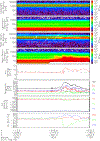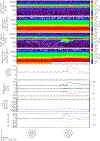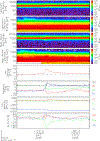Distribution and solar wind control of compressional solar wind-magnetic anomaly interactions observed at the Moon by ARTEMIS
- PMID: 33479575
- PMCID: PMC7816726
- DOI: 10.1002/2017ja023931
Distribution and solar wind control of compressional solar wind-magnetic anomaly interactions observed at the Moon by ARTEMIS
Abstract
A statistical investigation of 5 years of observations from the two-probe Acceleration, Reconnection, Turbulence, and Electrodynamics of Moon's Interaction with the Sun (ARTEMIS) mission reveals that strong compressional interactions occur infrequently at high altitudes near the ecliptic but can form in a wide range of solar wind conditions and can occur up to two lunar radii downstream from the lunar limb. The compressional events, some of which may represent small-scale collisionless shocks ("limb shocks"), occur in both steady and variable interplanetary magnetic field (IMF) conditions, with those forming in steady IMF well organized by the location of lunar remanent crustal magnetization. The events observed by ARTEMIS have similarities to ion foreshock phenomena, and those observed in variable IMF conditions may result from either local lunar interactions or distant terrestrial foreshock interactions. Observed velocity deflections associated with compressional events are always outward from the lunar wake, regardless of location and solar wind conditions. However, events for which the observed velocity deflection is parallel to the upstream motional electric field form in distinctly different solar wind conditions and locations than events with antiparallel deflections. Consideration of the momentum transfer between incoming and reflected solar wind populations helps explain the observed characteristics of the different groups of events.
Figures











References
-
- Angelopoulos V (2011), The ARTEMIS mission, Space Sci. Rev, 165, 3–25, doi:10.1007/s11214-010-9687-2. - DOI
-
- Auster HU, et al. (2008), The THEMIS fluxgate magnetometer, Space Sci. Rev, 141, 235–264.
-
- Bale SD, et al. (2005), Quasi-perpendicular shock structure and processes, Space Sci. Rev, 118, 161–203.
-
- Chapman SC, and Dunlop MW (1986), Ordering of momentum transfer along VνB in the AMPTE solar wind releases, J. Geophys. Res, 91, 8051–8055, doi:10.1029/JA091iA07p08051. - DOI
Grants and funding
LinkOut - more resources
Full Text Sources
